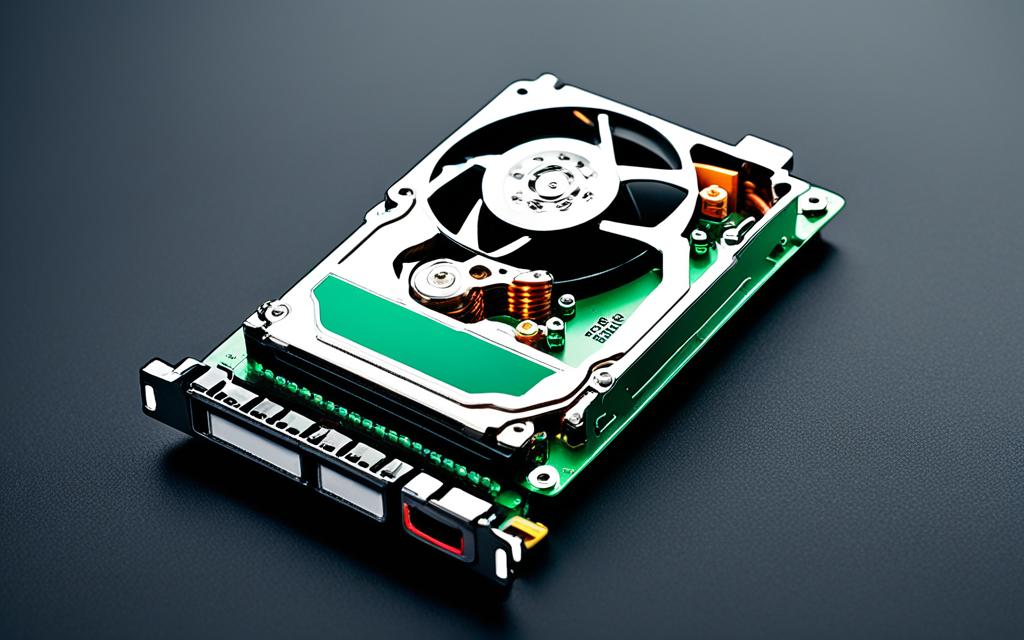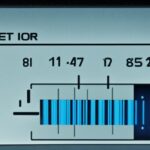Table of Contents
The journey of SATA HDD drives is a big step in data storage. These drives play a key role in modern tech. They connect smoothly to devices like servers, gaming machines, and PCs, boosting user experiences and performance. SATA technology has kept up with time, shaping our interaction with digital stuff across many devices.
If you want to better your system or just know how your gadgets work, understanding these hard drives is a must. It helps you make your digital setup better and enjoy your tech adventures more. For more info, check SATA technology to see how important it is in our tech-filled lives1.
Key Takeaways
- SATA drives play a crucial role in connecting various storage devices in modern computers.
- The architecture of SATA allows for superior data transfer speeds, especially with the advancements in SATA III.
- Understanding the differences between SATA HDDs and SSDs is vital for informed upgrading decisions.
- SATA technology has a rich history and continues to evolve, offering many compatibility options.
- Utilising SATA can enhance gaming performance, especially when integrated with NVMe SSDs.
Introduction to SATA Technology
SATA technology has changed how we store and transfer data. Its history shows the evolution of this interface. It started in 2003, replacing the older Parallel ATA (PATA). SATA’s simpler design has just seven conductors, unlike PATA’s bulky connectors. This change has greatly improved how storage devices perform and function in various settings.
History of SATA
The journey of SATA technology began with its first version, SATA 1.0. It had a transfer rate of 1.5 Gbps, mainly used in personal and office computers2. Following versions improved performance. For example, SATA 2.0 doubled the rate to 3.0 Gbps and added new features like port multipliers2.
SATA 3.0 then increased the speed to an impressive 6.0 Gbps. It also ensured compatibility with previous versions. This was crucial for handling larger data transfers2. The latest updates, SATA 3.1 to 3.3, focus on supporting portable storage and new technologies. These improvements have kept SATA relevant in modern computing2.
Why SATA is Still Relevant Today
Even with the rise of SSDs and fast technologies like NVMe, SATA remains important. It works with many devices, from desktops to gaming consoles. Its design offers data transfer speeds of up to 600 MB/s in the latest version3. SATA also supports various connectors, making it flexible for different uses.
SATA’s 15-pin power connector updates older setups. It supports drive sizes of 2.5 and 3.5 inches3. Advances in SATA, like more compact cables, help it fit into tight spaces. These developments extend SATA’s reach across many types of equipment and setups.
| Revision | Max Transfer Rate | Key Features |
|---|---|---|
| SATA 1.0 | 1.5 Gbps | First introduction to personal computing |
| SATA 2.0 | 3.0 Gbps | Doubled speed with port multipliers |
| SATA 3.0 | 6.0 Gbps | Backward compatible, enhanced performance |
| SATA 3.1 | — | Final design for storage modules |
| SATA 3.2 | — | Introduced SATA Express for simultaneous use |
| SATA 3.3 | — | Focused on shingled magnetic recording |
What Is SATA HDD Drive?
SATA hard drives are very popular for storing data in computers. They are reliable and perform well, offering a special interface to speed up data handling. This makes them great for both personal and work use.
Definition and Key Features
SATA drives came out in 2003 and soon became key for computers. They have impressive features like:
- Fast communication up to 6 Gb/s, hitting 600 MB/s max speed
- Big storage sizes from 500 GB to 16 TB
- Added tech like Native Command Queuing (NCQ) in newer versions
- They work with older ATA drives too, making them very versatile
- They’re faster and more efficient than older PATA drives
The technology of SATA drives has kept improving, making them faster over time. With versions like SATA 3.0 and 3.2, speeds have increased significantly45. They’re built to last about 3 to 4 years, even with lots of use4.
Comparison with Other Types of HDDs
When we compare SATA with PATA and SSD, SATA leads in speed and efficiency. Each storage type has its pros and cons. SATA offers large, affordable storage, while SSDs are quicker.
| Feature | SATA HDD | PATA HDD | SATA SSD |
|---|---|---|---|
| Standard Speed | Up to 6 Gb/s | Up to 133 MB/s | Up to 12.4 Gb/s |
| Typical Capacity | 500 GB – 16 TB | Up to 2 TB | Up to 8 TB |
| Cost | Budget-friendly | Generally less expensive | Higher than SATA HDDs |
| Durability | Less durable, mechanical parts | Similar concerns | More durable, shock-resistant |
SATA HDDs balance price with performance well. But SSDs, though pricier, offer faster speeds. They’re better for high-demand tasks like gaming or video editing.
New developments in storage technology keep changing what users expect. This keeps SATA hard drives, along with SSDs and PATA drives, critical in the world of storage45.
Technical Details of SATA Drives
SATA drives’ technical specs are key to knowing how they perform and fit in today’s computers. Looking closely at SATA HDD sizes and how they send data shows us their efficiency. It also shows how useful they are in different situations.
Physical Specifications and Sizes
SATA drives come in two main sizes: 3.5 inches for desktops and 2.5 inches for laptops. This makes them ideal for a wide range of gadgets, from big desktops to small laptops. The start of SATA technology in 2000 brought many improvements. These include smaller cables, cost savings, and the ability to swap parts without shutting down the computer6.
Data Transmission Speeds
The growth of SATA data transfer rates shows big tech leaps. SATA 1.0 started with a speed of 1.5 Gbit/s. SATA 2.0 then doubled it to 3.0 Gbit/s. Now, SATA 3.0 offers a fast 6.0 Gbit/s. This speed makes sure data moves quickly and improves overall performance6.
This development doesn’t just show what SATA drives can do. It also shows they can compete with SSDs. Although SSDs are quicker, they’re also more expensive7.
| SATA Revision | Data Rate (Gbit/s) | Theoretical Transfer Rate (MB/s) |
|---|---|---|
| Revision 1.0 | 1.5 | 150 |
| Revision 2.0 | 3.0 | 300 |
| Revision 3.0 | 6.0 | 600 |
Knowing these SATA drive specifications helps shoppers pick the right storage. It also helps them keep an eye on and handle their data well. Understanding SATA’s features lets users make smart choices. This is great for everything from gaming to streaming and makes digital life better7 data consumption.
SATA Connectors: Types and Usage
SATA connectors are key to SATA HDDs working well, linking data and power. Knowing the types of SATA connectors helps users improve their systems. The usual data connector has six pins for sending data. The power connector uses fifteen pins, providing +3.3V DC, +5V DC, and +12V DC from the power source8. This variety ensures devices work together better.
Data and Power Connectors Explained
Different SATA connectors like Micro SATA, E-SATA, and SATA Power connectors are crucial. SATA’s design is neater and takes up less space than old PATA systems. This means cables are easier to handle9. This design helps make connecting devices simpler and more secure.
Hot-Swapping Capability
SATA technology’s coolest trick is letting users switch drives without turning off the system. This is possible because of several ground pins in the SATA power connector. These make changing devices smooth8. Knowing how to use this can greatly improve the use in busy settings where stopping is not an option.
Explore more about types of SATA connectors and their
FAQ
What are SATA HDD drives and their significance?
SATA HDD drives are crucial for storing data. They’re used in desktops, laptops, and gaming consoles. Their reliable data transmission improves digital experiences.
How did SATA technology evolve over the years?
SATA technology started in 2003, taking over from Parallel ATA (PATA). It has gotten faster over time, moving from 1.5 Gbit/s to 6 Gbit/s. It also added useful features like Native Command Queuing and hot-swapping.
Why is SATA technology still relevant today?
SATA is still popular because it works with many devices and is cost-effective. It’s a good choice for users wanting more storage without spending too much.
What are the key features of SATA HDDs?
SATA HDDs offer large storage and reliable data transmission. They’re available in two sizes and are more affordable than SSDs. They’re better than old PATA drives.
How do SATA HDDs compare with SSDs and PATA drives?
SATA HDDs have more storage for less money than SSDs. They’re more efficient than PATA drives because of their better connection design. This makes data transfer faster.
What are the physical specifications of SATA drives?
Desktop-sized SATA HDDs are 3.5 inches. Laptop versions are 2.5 inches. Knowing these sizes helps with fitting them into different systems.
What are the data transmission speeds for SATA drives?
SATA drives now reach up to 6 Gbit/s with SATA III. This speed boost significantly improves the performance of storage devices.
What types of connectors do SATA drives use?
SATA drives have a six-pin data connector and a fifteen-pin power connector. Knowing about these connectors helps with easy setup in computers.
Can SATA drives be hot-swapped, and why is it important?
Yes, you can hot-swap SATA drives. This lets you change or add drives without shutting down. It makes managing storage simpler and more flexible.
Source Links
- https://recoverit.wondershare.com/hard-drive/what-is-sata.html – What Is SATA? How Does SATA Work?
- https://www.techtarget.com/searchstorage/definition/Serial-ATA – What is Serial ATA? An Introduction to SATA
- https://www.ufsexplorer.com/articles/key-terms/sata-drive/ – What is a SATA drive? An Introduction to the interface
- https://www.cleverfiles.com/help/sata-hard-drive.html – What is a SATA hard drive? Definition & data recovery process
- https://www.pluralsight.com/blog/it-ops/types-of-hard-drives-sata-ssd-nvme – SSD Guide
- https://en.wikipedia.org/wiki/SATA – SATA
- https://abmfederal.com/a-comparison-between-data-storage-solutions-sata-vs-ssd-hdd/ – A Comparison Between Data Storage Solutions – SATA vs SSD & HDD
- https://tripplite.eaton.com/products/sata-cables-and-speeds-compared – SATA Cables and Speeds Compared | Eaton
- https://www.minitool.com/lib/sata-cable.html – What Is the SATA Cable and the Different Types of It – MiniTool








